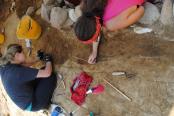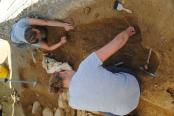CAMPAGNA 2019 |
1° SETTIMANA |
2° SETTIMANA |
3° SETTIMANA |
4° SETTIMANA |
5° SETTIMANA |
6° SETTIMANA |
7° SETTIMANA |
8° SETTIMANA |
9° SETTIMANA |
10° SETTIMANA |
01 AGOSTO 2019 
Resoconto della giornata di scavo
Area 6000
NORTH SECTOR
Along the western boundary of the area we proceeded with the documentation and removal of the poorly preserved remains of the individual USK 6526, whose tibias collapsed towards the center of the tomb, disarticulated from the respective femurs, probably due to the tafonomic processes related to decomposition of the buried below (USK 6559) and of the wooden plank that separated the two bodies. Further east, the US 6552 filling and the exposure of the individual USK 6562, WE oriented and lying supine south of the lithic case, which probably intercepts part of the body, continues to be removed. In the northern portion of the sector the excavation of the US 6555 filling, with silt-clay matrix, has begun, which is highlighting the skeletal remains of an inhumated not very well preserved, datable probably to the XI century.
Northwest corner grave : Continued exposing and defining the os coxae, sacrum, vertebral column, femora of the individual. Uncovered ribs of the right thorax. Uncovered a humerus on the right side of the individual, thought to belong to an individual under this one, and thought to be in the prone position.
New grave was identified in the northern corner, below the cut US -6557. The surface was cleaned before this skeleton was identified. The sediment was removed one cm at a time to expose skeletal elements. The femurs were first exposed, articulated with the tibias and tarsals.
6000/s
We finiushed removing all of skeleton 6273 and began to turn our focus to the various reductions surrounding the grave.
Today we removed the rest of the skeleton 6276 and placed everything together in storage for the Osteology lab to look at next year. We then found the bottom of the grave cut, which was identified by a yellow brown clay. Then more pictures were taken of the now empty grave. We then switched to help remove the reduction of the large lithic tomb that is also in 6000S.
Area 7000
Today's digging focused on the furnace and trench features. Furnace excavation continued from previous days and resulted in more slag, charcoal, and today specifically, an animal bone (most likely a femur of a medium-sized animal). Excavation of the trench features began in the northern quadrant of area 7000, exposing one layer of the north-south trench and the east-west trench in the center of the area. both trenches resulted in pottery fragments. Finally, today's dig ended with exposing the east-west trench directly south of the central trench. This was exciting as it exposed a layer of large stones, perhaps remnants of an old wall.









